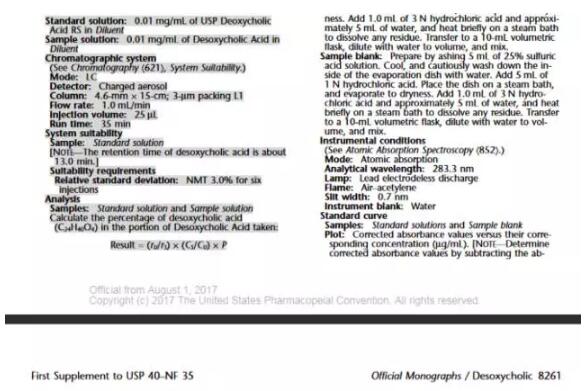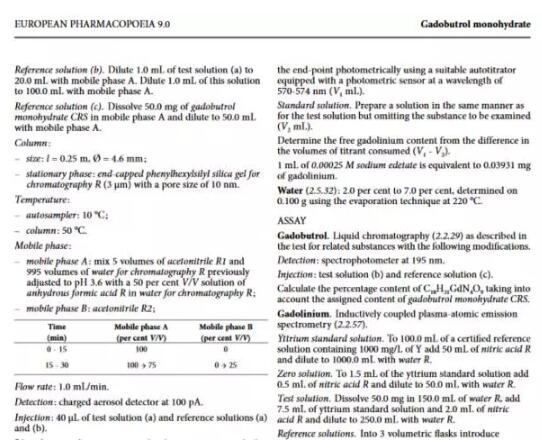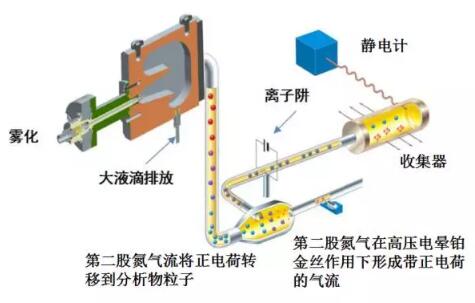Recently, USP 40 NF 35 S1 and EP genoprostol (Ph. Eur. 04/20/16: 2735) were included in the USP, and the main component content or impurity analysis method was adopted. Electro-fog detector (CAD) for measurement is undoubtedly the official recognition of this new detector. In addition, the EP test recommended the use of CAD detection of aspartic acid and its impurities, topiramate and its impurities and ibandronate and its impurities; USP Forum recommended CAD test varieties and metoprolol succinate weak UV absorption and no UV absorption of impurities. Deoxycholic acid ( USP ) Gadobutrol ( EP ) Electro-fog detector (CAD) is a general-purpose detector. It is a new type of principle, high sensitivity and reproducible detector. It is based on the principle of atomization detector. The eluent is atomized to form particles. After drying through the evaporation tube, it collides with the charged nitrogen gas to make the surface of the analyte particles positively charged, and finally the amount of charge on the surface of the analyte particles is measured by an electrometer. Quantitative basis of CAD: The peak area is related to the amount of charge on the surface of the analyte particle, and the surface charge of the analyte particle is related to the mass of the analyte. Based on a unique new design principle, the electro-fog detector solves some limitations of other detector designs and principles, achieves universality, provides consistent responsiveness to difficult-to-volatile compounds, and achieves high sensitivity and low sensitivity. Detection limit, it is easy to detect nanograms of compounds, and combined with liquid chromatography separation system, its reproducibility, stability is very good, so it can be accurately used for quantitative analysis or semi-quantitative analysis, can quantify most Non-volatile and semi-volatile organics. Since its launch in October 2004, the electro-fog detector has won the highest honor in the instrument industry. It was awarded the 2006 PITTCON “Contributor†Silver Award and the “Nobel Prize in Invention†2005 R&D100 Award. . A recent detailed introduction to the detector principle and technical application "Charged Aerosol Detection for Liquid Chromatography and Related Separation Techniques" has also been published, providing a comprehensive and detailed technical guide for users of the detector. CAD detector CAD detector principle Compared to ELSD, CAD has higher detection sensitivity, better intra-day and day-to-day repeatability, and a wider linear range. Many impurities that ELSD cannot detect have a good response on CAD. Compared with ELSD, the CAD response of the non-volatile compounds is independent of the physical and chemical properties of the analytes. The different compounds with the same injection volume have the same CAD response without changing the mobile phase composition into the CAD. In other words, CAD can quantify unknown compounds using a linear curve of known compounds. In addition, the data obtained by CAD for compound purity analysis is closer to the true composition of the sample. Compared with UV, the response of CAD is not affected by the UV absorbing group of the compound. The semi-volatile and non-volatile compounds have better response in CAD and can detect weak UV absorbing compounds that UV cannot detect. The electro-fog detector has the following main features: - Based on the design principle and structure of the detector, the detector is generally highly sensitive, such as 0.5 ng of column loading when analyzing glucose, sucrose and lactose; - Higher response consistency, such as direct injection of 1μg (without column) for the 24 compounds under the same chromatographic conditions, the RSD value of the peak area of ​​the response is only 10.7%; - Dynamic detection range is wide, up to 3-4 orders of magnitude; - Wide range of applications, analysis of small molecules, macromolecular compounds such as amino acids, proteins, polymers, etc.; - Easy to use and easy to maintain, with a working flow rate of 0.01-2.00 ml/min, compatible with Micro-LC and UHPLC. Since its inception in 2004, CAD has become irreplaceable in many fields such as drugs, proteins, phospholipids, steroids, oligosaccharides, surfactants, carbohydrates, polymers, ions and peptides. The advantages. The inclusion of CAD detection methods by USP and EP is a great encouragement to our domestic CAD users. This is not only the first time that USP and EP have included CAD detection technology. The implementation details of these two methods provide a blueprint for the writing of other CAD related methods in the future. As we rely more and more on this detector in our daily tests, we expect that the detection method using this detector will be included in our Chinese Pharmacopoeia in the near future. Note: For those interested in the methods included in the USP and EP mentioned in the article, if it is not convenient to download the USP and EP original text, you can contact the Thermo Fisher Scientific Local Sales or Application Center to request the full text. Kjeldahl Nitrogen Analyzer,Automatic Kjeldahl Nitrogen Analyzer,Kjeldahl Protein Analyzer,Multi-Protection Function Analyzer Guangdong Widinlsa International Co.Ltd , https://www.gdwidinlsa.com



